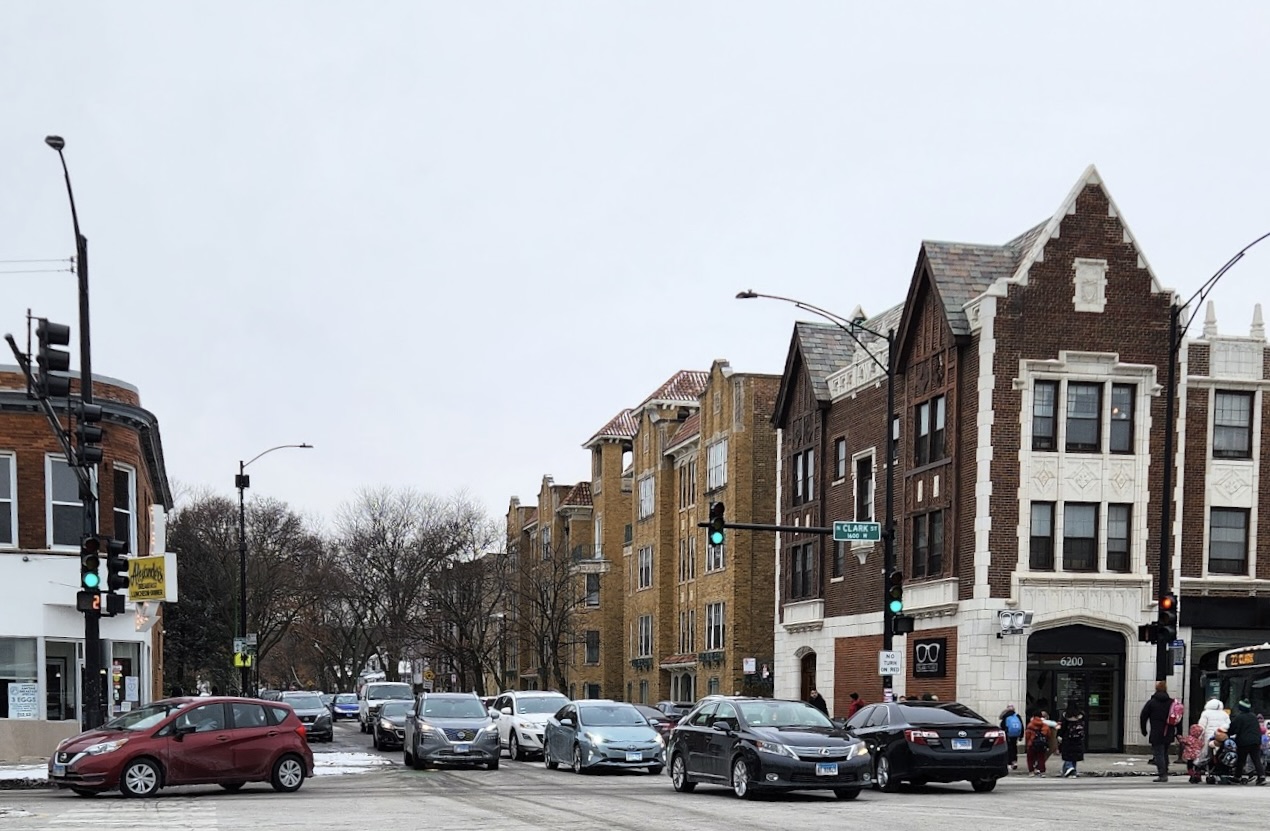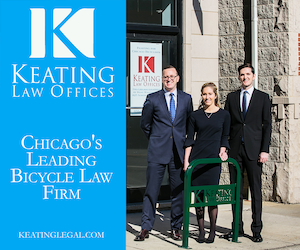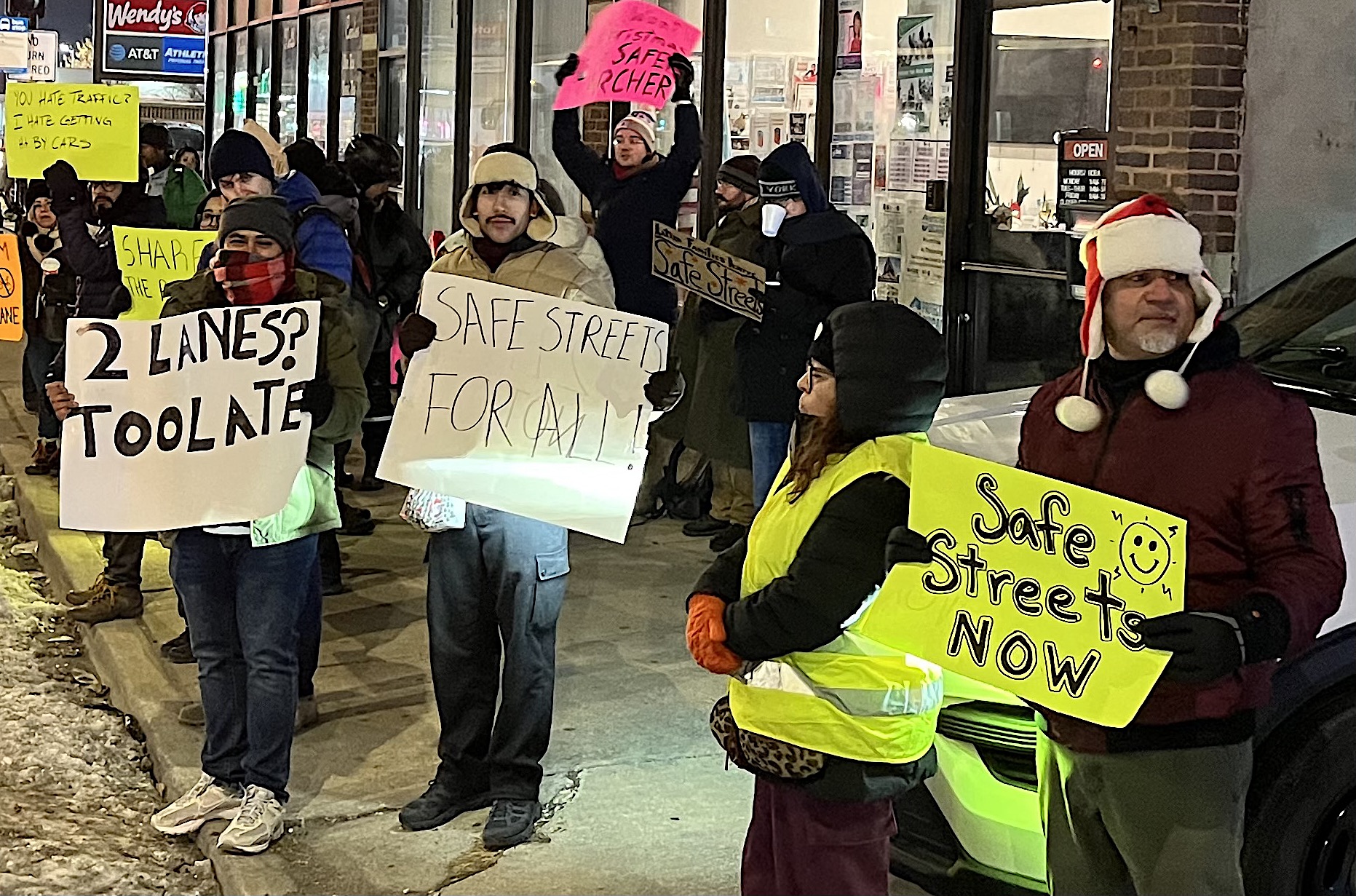
This post is sponsored by Keating Law Offices.
Before yesterday's virtual meeting on the Granville Avenue Traffic Safety proposal, hosted by the Chicago Department of Transportation and the 40th, 48th, and 50th wards, things were getting edgy in Edgewater.

In a nutshell, this project would address high traffic volumes, and frequent speeding and crashes, on a 2.8-mile stretch Granville (6200 N.) between Kedzie Avenue (3200 W.) and Sheridan Road (1000 W.) in Edgewater and West Ridge. This situation exists because Granville, a side street, is halfway between Devon (6400 N.) and Peterson (6000 N.) avenues, and motorists often try to avoid traffic jams by using Granville as a "cut-through" route across neighborhoods. To counter this, CDOT has pitched making sections of the avenue one-way for drivers, with "contraflow" lanes to allow two-way bicycle and e-scooter riding, and adding other traffic calming infrastructure.
This strategy would make Granville safer for vulnerable road users, including kids heading to the corridor's many schools and parks; help prevent car-on-car crashes; and improve the livability of the corridor for residents. It would also create the only low-stress, east-west sustainable transportation route in the nearly two-mile segment between bikeways on Pratt (6800 N.) and Berwyn (5300 N.) avenues.
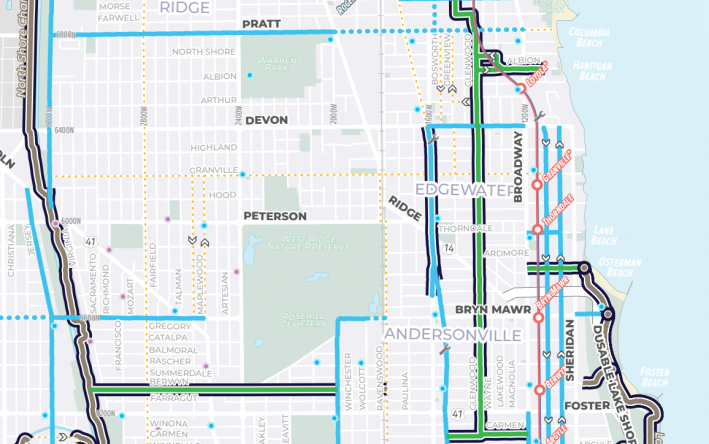
Needless to say, members of the windshield set were upset to hear that they might lose one of their favorite "crafty" crosstown routes. The Edgewater Glen Association, which represents an enclave south of Granville between Clark Street (1600 W.) and Broadway (1200 W.), insisted in a blog post that "Our neighborhood needs this collector street," and the proposal would "cause chaos."
Streetsblog's article in response noted that Granville isn't actually designated as a "collector" road for through traffic by the City and State, but rather a "local street," and it shouldn't be used for long-distance trips. We also pointed out that EGA's claims that lots of traffic would be diverted on to other side streets, and that the Chicago Fire Department said the redesign would cause problems (on the contrary, CFD provided input for the plan) were misleading. As you can see from EGA's response post, excerpted below, the association wasn't happy about our piece.

Look, we don't have any problem with EGA's decades-long neighborhood upgrade efforts, just their current misguided opposition to safer streets. I didn't feel the need to contact the group for a comment on Granville, since there are many thousands of words in opposition to the proposal on their website. As for "attacking one officer by name," I simply mentioned that the author of the largely anonymous "chaos" article is board president John Dale, and cheekily suggested that he and the association "learn to stop worrying and love the Granville [project]."
Of course, that didn't happen. Here's an alarmist flier the Edgewater Glen Association put out in advance of yesterday's hearing.

The good news for EGA at the meeting was that most of their questions and claims were addressed. The bad news, from their perspective, was that CDOT announced that construction for the project will move forward later this year – more on that in a bit.
The first part of yesterday's hearing on the project covered the section of Granville between Clark and Lake Michigan (or as Governor JB Pritzker recently declared, Lake Illinois.) Local Ald. Leni Manaa-Hoppenworth (48th) opened the discussion. "This is about your safety, about your neighbors' safety, especially the older adults and the younger folks in our neighborhood," she said.
Next, CDOT Deputy Commissioner and Chief Traffic Engineer Malihe Samadi gave some background on the proposal. She said the project has its roots in 2013, when then-CDOT chief Gabe Klein led the creation of the department's Complete Streets Guide. "[It] challenged us to come up with a hierarchy of road users... pedestrians first, transit users next, then bicyclists, and then automobiles," she said. "With this hierarchy, we challenged our planners and engineers to think outside the box and stay away from car-centric planning and design."

After that, CDOT Complete Streets Director David Smith provided updates on the Granville project. He noted that the avenue is in the top 10 percent of crashes for local neighborhood streets citywide, and more than half of the pedestrian and bike collisions in the area take place there. In the past five years, there have been 664 total crashes on the avenue, with 162 people suffering injuries. About 88 percent of the drivers who injured people on Granville came from outside the neighborhood.
Smith added that, since the last community meeting on the Granville safety project on October 15, there have been 63 more crashes on the corridor, 14 of them hit-and-run collisions, with 16 people injured. Almost half of the incidents took place during school pickup and drop-off hours.
"We've heard from a parent of a child in the neighborhood [who] was biking to school on Granville, got hit, and was significantly injured," Smith said. "Since the meeting there was... a mother crossing the street with her three children and was struck by [a hit-and-run driver.] So these are real issues that continue to happen."
Discussing the October meeting at Misericordia, 6300 N. Ridge Ave., Smith said that over 200 people attended, and out of 119 comments left expressing an opinion for or against the proposal, 76 percent were in favor of it. So it seems the opponents may simply be a noisy minority.
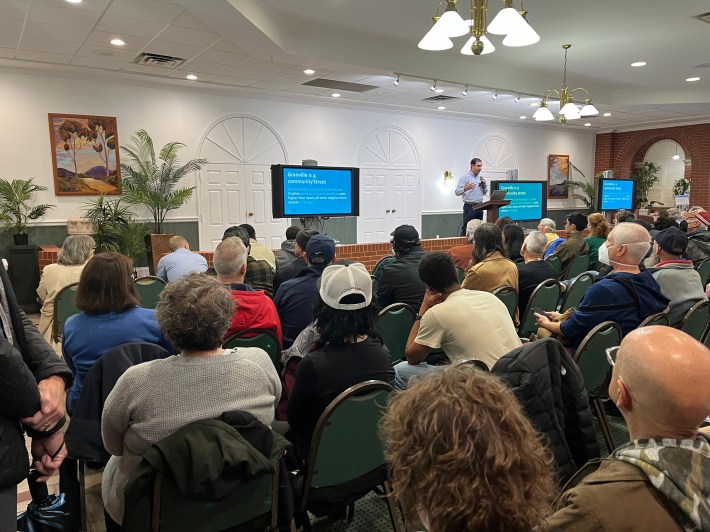
The Complete Streets director then addressed some of the many questions CDOT has heard about the Granville initiative, including several of issues raised by the Edgewater Glen Association:
• "Why are there so many crashes on Granville?" Smith said this is due to narrow street width, high traffic volumes and speeds, and the large amount of activity, including people accessing schools and park, happening on the avenue.
• "Isn’t Granville a 'Collector Street'?" He noted that CDOT, the Illinois Department of Transportation, and the Federal Highway Administration classify the avenue as a "Local Street," "not intended for use in long-distance travel," according to the FHWA. Interestingly, the map CDOT put together to illustrate this, based on IDOT data, is very similar to the detail from IDOT's street classification map for Cook County that Streetsblog posted last week to prove this point. Great minds think alike!

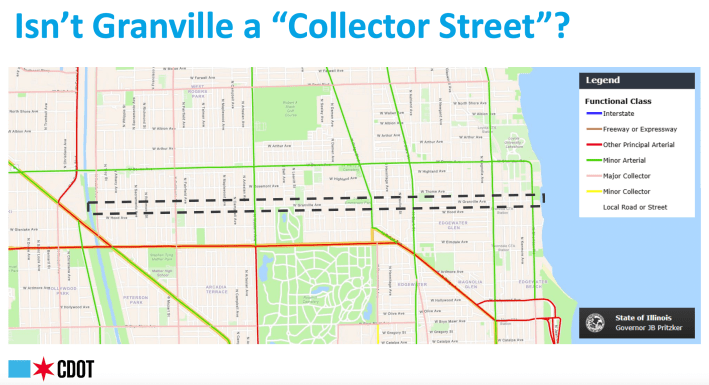
• "Can Granville be reclassified as a 'Collector Street'?" No, Smith explained, because it doesn't meet the FWHA and IDOT requirements for collectors. On some some stretches the avenue is 14 feet narrower than the standard for that kind of the street. That helps explain why sideswipe crashes, such as motorists running against parked cars are common there.
• "Can you achieve the same project goals with only traffic calming elements?" No, because more people currently drive on Granville per day than the street is designed to accommodate, Smith said. That calls for reducing the number of non-local trips on the avenue, in addition to calming traffic and better organizing pedestrian, bike/scooter, and motor vehicle traffic.
• "How will changes to Granville impact traffic in the neighborhood?" He discussed the traffic movements illustrated in the following map.

• "Will this impact emergency services?" No, Smith said. He explained that CDOT has worked with the fire department to ensure that all intersection designs can accommodate the largest CFD vehicles. Firefighters, EMTs, and police officers will be permitted to travel both ways on the one-way segments. And he said fewer drivers and better organization of the street will actually help reduce delays for first responders.

As for the question on the Edgewater Glen Association's flyer, "What is being done to keep traffic from simply diverting diverting onto other local streets?" Smith had this explanation. "When we say that there's too much traffic on Granville, it's too much traffic in the context of a residential neighborhood street," he said. "But it's a very small amount of traffic in the context of the surrounding network. And so a lot of non-local trips will simply be diverted or filtered out to the arterial street network."

"That could be Devon, it could be Peterson, it could be Western [Avenue, 2400 W.]," Smith added. "It could be down to Foster [5200 N.] or up to Pratt, or to other streets north and south. But we anticipate that there's going to be a lot of traffic that's going to filter out of the neighborhood, and people will make decision points, especially those who are using Granville for longer distances, to use other streets within the network."

He also noted that very few of the other nearby side streets parallel to Granville provide any kind of connectivity, with no stoplights or four-way stops signs at major street crossings, and many of them have speed humps. "So there's very little benefit to using these other streets for any kind of cut-through traffic."
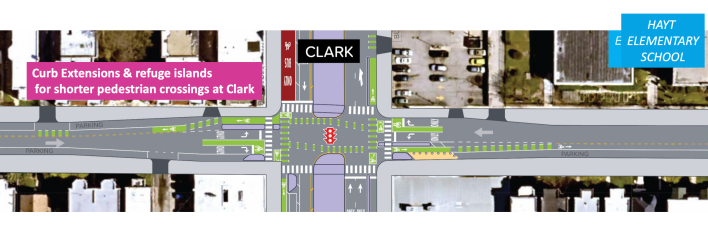
After addressing many of the questions and concerns that had been previously voiced about the project, Smith said CDOT will be moving forward with what was being presented at last night's meeting. Installation will take place during summer 2025, with the department coordinating with the Granville schools to minimize impacts on their summer programming. The goal is to finish before the fall school year starts. In the near future, CDOT will provide more details about the construction schedule to the ward offices to share with constituents.

Smith then walked the meeting attendees through the new street design, block-by-block from Sheridan to Kedzie. This article is getting a little long, so I've just embedded images of some of the key intersection designs, and you can click on the meeting presentation link if you want the nitty-gritty.
But to wrap up this post, I'll include a few exchanges from the Zoom meeting's Q&A screen, in which Ald. Andre Vasquez (40th) did a good job of fielding questions. His knowledge of sustainable transportation issues is fairly impressive, considering that he didn't even learn to ride a bicycle until 2022.

Attendee Jen Bills: "Why couldn’t we try this temporarily with temporary cones and signage before investing in permanent infrastructure, and see how it impacts the near arterial and side streets?"
Ald. Vasquez: "We did make the case to CDOT that a pilot would be helpful, and their response is that what has occurred in the past is that people take down any temporary fixtures in ways that make it less safe and don't recreate the experience."

"SK": "Are you not at all concerned about the increased travel times that this will cause?... I anticipate long backups on Granville."
Ald. Vasquez: "If [drivers making crosstown trips] are disincentivized from using Granville because it is no longer a convenient cut-through, it then leads to less cars overall and makes it easier to get home for local drivers."

Mort Hart: "[Is there] any plan to have bikers contribute to the cost? [That] would seem to be logical."
Ald. Vasquez: "We think it's absolutely fair to ask cyclists to contribute when a bike grid is completed, in the way roads are completed for drivers. Cyclists already pay taxes as well."
David Smith said CDOT will post an FAQ sheet about the Granville initiative, as well as video of yesterday's Zoom meeting, on the department's Complete Streets project webpage next week.
View last night's meeting presentation images here.

Did you appreciate this post? Streetsblog Chicago is currently fundraising to help cover our 2025-26 budget. If you appreciate our reporting and advocacy on local sustainable transportation issues, please consider making a tax-deductible donation here. Thank you!
